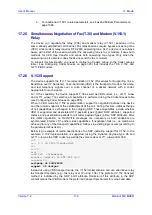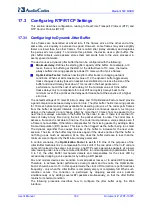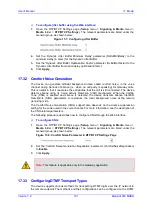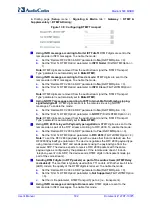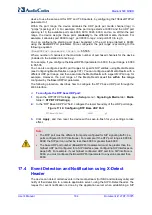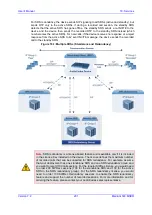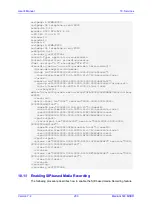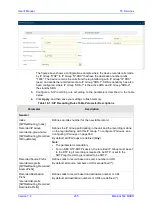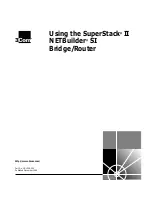
User's Manual
190
Document #: LTRT-10375
Mediant 500 MSBR
Contact: <sip:100@10.33.2.53>
X- Detect: Response=AMD,CPT
Content-Type: Application/X-Detect
Content-Length: xxx
Type = CPT
Subtype = Beep
17.5 Answering Machine Detection (AMD)
The device's Answering Machine Detection (AMD) feature can detect whether an outbound
call (SBC or Gateway call) has been answered by a human (including fax) or an answering
machine. The device analyzes the sound (speech) patterns received in the first few
seconds of the call to determine whether a human (live person) or machine has answered
the call. Typically, when a human answers the call, there is a short "hello ..." followed by
silence to wait for the other party to respond. In contrast, when an answering machine
answers the call, there is constant speech (answering message) followed by a beep to
leave a voice-mail message.
When the device detects what answered the call (human or machine), it can notify this
detection type to, for example, a third-party application server used for automatic dialing
applications. The X-Detect SIP header is used for requesting event detection and
notification. For more information, see Event Detection and Notification using X-Detect
Header on page 184. The device can also detect beeps played by an answering machine
at the end of its greeting message. For more information, see Detecting Answering
Machine Beeps on page 187. You can also configure the device to disconnect IP-to-Tel
calls upon detection of an answering machine on the Tel side. For more information, see
Enabling IP-to-Tel Call Disconnection upon Detection of Answering Machine on page 193.
The device's default AMD feature is based on voice detection for North American English
(see note below). It uses AudioCodes' sophisticated speech detection algorithms which are
based on hundreds of real-life recordings of answered calls by live voice and answering
machines in English. The algorithms are used to detect whether it's human or machine
based on voice and silence duration as well as speech patterns. The algorithms of the
language-based recordings are compiled into a file called AMD Sensitivity. This file is
provided by default, pre-installed on the device.
Note:
As the main factor (algorithm) for detecting human and machine is the voice
pattern and silence duration, the language on which the detection algorithm is based,
is in most cases not important as these factors are similar across most languages.
Therefore, the default, pre-installed AMD Sensitivity file, which is based on North
American English, may suffice your deployment even if the device is located in a
region where a language other than English is used.
However, if (despite the information stated in the note above) you wish to implement AMD
in a different language or region, or if you wish to fine-tune the default AMD algorithms to
suit your specific deployment, please contact your AudioCodes sales representative for
more information on this service. You will be typically required to provide AudioCodes with
a database of recorded voices (calls) in the language on which the device's AMD feature
can base its voice detector algorithms. The data needed for an accurate calibration should
be recorded under the following guidelines:
Statistical accuracy: The number of recorded calls should be as high as possible (at
least 100) and varied. The calls must be made to different people. The calls must be
made in the specific location in which the device's AMD feature is to operate.
Real-life recording: The recordings should simulate real-life answering of a called
person picking up the phone, and without the caller speaking.
Normal environment interferences: The environment in which the recordings are done
should simulate real-life scenarios, in other words, not sterile but not too noisy either.
Summary of Contents for Mediant 500 MSBR
Page 2: ......
Page 33: ...Part I Getting Started with Initial Connectivity ...
Page 34: ......
Page 36: ...User s Manual 36 Document LTRT 10375 Mediant 500 MSBR This page is intentionally left blank ...
Page 40: ...User s Manual 40 Document LTRT 10375 Mediant 500 MSBR This page is intentionally left blank ...
Page 45: ...Part II Management Tools ...
Page 46: ......
Page 48: ...User s Manual 48 Document LTRT 10375 Mediant 500 MSBR This page is intentionally left blank ...
Page 115: ...Part III General System Settings ...
Page 116: ......
Page 132: ...User s Manual 132 Document LTRT 10375 Mediant 500 MSBR This page is intentionally left blank ...
Page 137: ...Part IV General VoIP Configuration ...
Page 138: ......
Page 290: ...User s Manual 290 Document LTRT 10375 Mediant 500 MSBR This page is intentionally left blank ...
Page 306: ...User s Manual 306 Document LTRT 10375 Mediant 500 MSBR This page is intentionally left blank ...
Page 380: ...User s Manual 380 Document LTRT 10375 Mediant 500 MSBR This page is intentionally left blank ...
Page 454: ...User s Manual 454 Document LTRT 10375 Mediant 500 MSBR This page is intentionallty left blank ...
Page 455: ...Part V Gateway Application ...
Page 456: ......
Page 460: ...User s Manual 460 Document LTRT 10375 Mediant 500 MSBR This page is intentionally left blank ...
Page 484: ...User s Manual 484 Document LTRT 10375 Mediant 500 MSBR This page is intentionally left blank ...
Page 494: ...User s Manual 494 Document LTRT 10375 Mediant 500 MSBR This page is intentionally left blank ...
Page 625: ...Part VI Session Border Controller Application ...
Page 626: ......
Page 654: ...User s Manual 654 Document LTRT 10375 Mediant 500 MSBR This page is intentionally left blank ...
Page 656: ...User s Manual 656 Document LTRT 10375 Mediant 500 MSBR This page is intentionally left blank ...
Page 741: ...Part VII Cloud Resilience Package ...
Page 742: ......
Page 751: ...Part VIII Data Router Configuration ...
Page 752: ......
Page 753: ......
Page 754: ......
Page 756: ...User s Manual 756 Document LTRT 10375 Mediant 500 MSBR This page is intentionally left blank ...
Page 757: ...Part IX Maintenance ...
Page 758: ......
Page 834: ...User s Manual 834 Document LTRT 10375 Mediant 500 MSBR This page is intetnionaly left blank ...
Page 837: ...Part X Status Performance Monitoring and Reporting ...
Page 838: ......
Page 848: ...User s Manual 848 Document LTRT 10375 Mediant 500 MSBR This page is intentionally left blank ...
Page 852: ...User s Manual 852 Document LTRT 10375 Mediant 500 MSBR This page is intentionally left blank ...
Page 854: ...User s Manual 854 Document LTRT 10375 Mediant 500 MSBR This page is intentionally left blank ...
Page 878: ...User s Manual 878 Document LTRT 10375 Mediant 500 MSBR This page is intentionally left blank ...
Page 880: ...User s Manual 880 Document LTRT 10375 Mediant 500 MSBR This page is intentionally left blank ...
Page 926: ...User s Manual 926 Document LTRT 10375 Mediant 500 MSBR This page is intentionally left blank ...
Page 927: ...Part XI Diagnostics ...
Page 928: ......
Page 950: ...User s Manual 950 Document LTRT 10375 Mediant 500 MSBR This page is intentionally left blank ...
Page 954: ...User s Manual 954 Document LTRT 10375 Mediant 500 MSBR This page is intentionally left blank ...
Page 956: ...User s Manual 956 Document LTRT 10375 Mediant 500 MSBR This page is intentionally left blank ...
Page 958: ...User s Manual 958 Document LTRT 10375 Mediant 500 MSBR This page is intentionally left blank ...
Page 974: ...User s Manual 974 Document LTRT 10375 Mediant 500 MSBR This page is intentionally left blank ...
Page 976: ...User s Manual 976 Document LTRT 10375 Mediant 500 MSBR This page is intentionally left blank ...
Page 977: ...Part XII Appendix ...
Page 978: ......
Page 982: ...User s Manual 982 Document LTRT 10375 Mediant 500 MSBR This page is intentionally left blank ...




